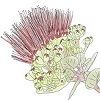6.2: Alternation of generations
- Page ID
- 59239
Before embarking on the exploration of the different groups of plants, let’s introduce the concept of alternation of generations in plant life cycles, which is inherited from the green algal ancestors of land plants. Alternation of generations means that plants alternate between two different life stages, or generations, in their life cycle; a haploid stage called gametophyte and a diploid stage called sporophyte. The terms haploid and diploid refer to the number of chromosomes contained in the cells. For example, most of the cells in the human body contain two sets of chromosomes (n) meaning they are diploid (2n): one set that we inherit from our mother (n) and one set we inherit from our father (n). However, humans also have special reproductive cells (eggs and sperm) that only have one set of chromosomes, and we call this haploid (n). These reproductive cells are called gametes and they are produced via cell meiosis (reductive cell division). When a male gamete (n) joins a female gamete (n) through fertilization, they form a diploid organism (2n).
Most of the plants we are familiar with, like trees, grasses, and tomatoes, have a dominant sporophyte stage, so the visible plant is diploid. Just like humans, plants also have specialized gametes that are haploid (n), which are found in their reproductive organs like flowers. However, instead of producing their gametes on a specialized structure on their diploid body (e.g. a flower on a tree), some plants have a prominent life stage where the whole plant is composed of haploid cells (n), and that haploid plant produces gametes. We call this haploid plant a gametophyte. The visible green body of some plants, like mosses, is actually the gametophyte. The alternation of generations in plants is an alternation between the gametophyte stage and the sporophyte stage.
In general, this is how the alternation of generations works: a male gametophyte (n) and a female gametophyte (n) produce gametes (sperm and eggs, respectively), which combine in fertilization to form a diploid plant called a sporophyte (2n). This sporophyte will grow and then produce spores, through meiosis, that will germinate into a new gametophyte (n), thus the alternating cycle is complete (Figure \(\PageIndex{1}\)). The specifics of this alternation are unique for each plant group, so we will revisit the alternation of generations for each one of the plant groups in subsequent chapters.


